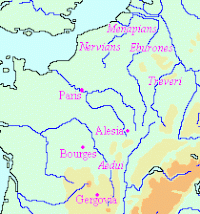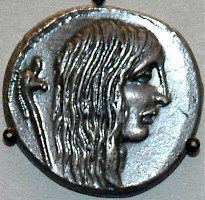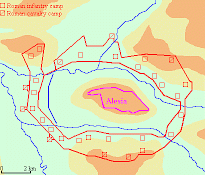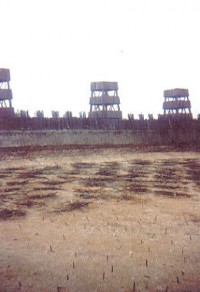Gaius Julius Caesar: Reconquest
Gaius Julius Caesar (13 July 100 - 15 March 44 BCE), Roman statesman, general, author, famous for the conquest of Gaul (modern France and Belgium) and his subsequent coup d'état. He changed the Roman republic into a monarchy and laid the foundations of a truly Mediterranean empire.
Reconquest (54-51)

In the first weeks of 53 BCE, Caesar was forced to face a serious crisis. His winter camps among the Belgians were built far from each other, and Belgian tribes could easily attack the legions. The leading tribe was that of the Treveri, who lived along the Moselle. One Roman legion, the Fourteenth, was annihilated and a second legion suffered severe losses during a rising led by Ambiorix, the leader of the tribe of the Eburones, who lived between the Meuse and Rhine near Tongeren, Maastricht, and Aix-la-Chapelle.
Although Caesar remained in control of the situation, it was obvious that Gaul was not yet fully conquered. Another cloud appeared on the horizon: from Rome came the message that Julia had died. As her father, Caesar will have mourned his daughter; as a politician he must have understood that the friendship with Pompey was no longer certain.
At this stage of the war, Caesar faced another, less urgent problem. The soldiers of his oldest legions (VII, VIII, VIIII and X) had been in his service for six years, the maximum length of service. They renewed their contracts.

When the uneasy winter was over, Caesar must have decided to teach the Belgians a lesson for once and for all. He received reinforcements: one legion to substitute the annihilated legion, an additional legion (the fifteenth) and one of the legions that guarded Italy (the first).
The Nervians, who had already been decimated, were again victims of naked aggression, after which the Menapii in the marshlands along the Rhine experienced the same horrors. A second Rhine crossing followed, and Germanic tribes may have been forced to go with the current to the now empty country of the Menapii. (Other Germans were to be Caesar's bodyguard until his death: the Chatti.) Nearly all Eburones were killed; three hundred days after the revolt of Ambiorix, his tribe had disappeared. Ambiorix fled to the country across the Rhine and did nothing to help his compatriots during the genocide. After these atrocities, winter quarters were build between the Seine and the Loire.
The year 52 BCE saw an even more serious rising than that of the winter of 54/53. For the first time, almost all nations in Gaul united under one commander, Vercingetorix (whose name means 'victor in 100 battles'). Only the Belgians, who were still lamenting the disaster of the preceding year, remained aloof. The Gauls had chosen an excellent moment, because the situation in Italy was unquiet too, and Caesar could not be reinforced. For the first time during this war, the Romans were was forced to defend themselves: Caesar was forced to recall his armies from the north, and meanwhile had to try to hold the south.
He was reinforced, however. He received two legions from the Senate (the first and third), and built two new legions, VI Ferrata and V Alaudae. The second of these was recruited in Gaul, which proves that Caesar generously gave the Roman citizenship to the new subjects of the empire.
Vercingetorix decided to drive away the Romans by cutting them off from forage and supplies. Therefore, the Gauls destroyed their own towns (e.g., Lutetia), and stored everything in a few impregnable towns. The Romans were forced to attack these towns, and the army of the Gauls would attack the Romans when they laid siege to these strongholds. Vercingetorix thought that this strategy would force the Romans back from Gaul into the Provence.

However, he had underestimated his adversaries. Caesar knew how to inspire his men (text). Using elaborate siege works, the Romans managed to take the stronghold of Bourges, killing 39,000 Gauls (text). But the Gauls remained optimistic, and even the Aedui, Caesar's allies, rebelled. Soon after their insurgence, the Romans failed to take Gergovia. Meanwhile, the legions from Belgium on their way to the south found their ways barred by the Gauls, but they managed to cross the Seine in the neighborhood of Paris, and three days later they contacted Caesar's defeated army. Having his armies united, Caesar was able to block Vercingetorix in a formidable fortress called Alesia. This site was too high to be stormed, so Caesar had to starve his enemies, who had lots of food (text).

The Romans decided that they could wait, and built enormous fortifications (the remains of which have been excavated in the nineteenth century). First, the 45,000 Roman soldiers built one line to keep some 80,000 Gauls in; then, they constructed a second line to defend the Romans against allegedly 250,000 warriors of the Gallic rescue force, which was besieging the besiegers. During this siege, terrible things happened: the Gauls sent away their wives and children, and the Romans refused to let them pass their lines. They were starved to death between the lines. In the end, Roman fortifications proved superior to Gallic numbers, and Vercingetorix surrendered.
The whole of Gaul was now conquered for the second time. Six million people had been living in Gaul before Caesar arrived in 58; one million had been killed and one million had been sold as slaves when he left in 50. Caesar himself wrote in his Commentaries on the War in Gaul that peace had been brought to the whole of Gaul. It is not hard to see that this was the peace of a graveyard.